The American Oystercatcher (Haematopus palliatus) is a captivating shorebird known for its striking appearance and unique behaviors along the coasts of North and South America.
With its distinctive black and white plumage, vital orange bill, and loud piping calls, this species stands out against the backdrop of sandy beaches and rocky shorelines.
Found in a variety of coastal habitats, from mudflats to salt marshes, the American Oystercatcher is well-adapted to its environment, utilizing its specialized bill to feed on bivalve mollusks and other invertebrates.
From territorial displays to intricate courtship rituals, these birds exhibit a fascinating array of behaviors that provide insights into their ecological role and conservation needs.
Understanding the life of the American Oystercatcher offers a glimpse into the dynamic interplay between these birds and their coastal habitats, highlighting the importance of preserving these ecosystems for future generations. Stay sharp.
How to Identify an American Oystercatcher?
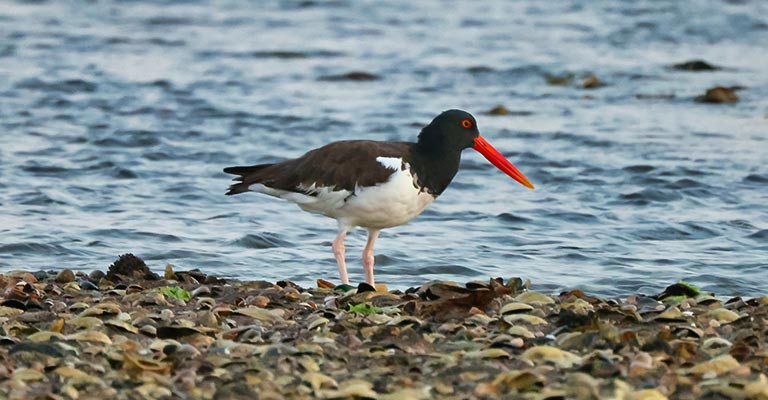
The American Oystercatcher is a striking shorebird characterized by its distinctive appearance and behavior. Here’s a detailed guide on how to identify this bird:
Size and Shape
American Oystercatchers are medium-sized birds with long, thick orange bills and stout bodies. They have a distinctive silhouette with a slightly hunched posture, long legs, and a rounded head.
Coloration
Their plumage is primarily black on the upperparts, extending from the head down to the tail.
The underparts are white, contrasting sharply with the black back. Their legs are pink, and their eyes are bright yellow, adding to their distinctive appearance.
Bill
The most striking feature of the American Oystercatcher is its long, thick, and lively orange bill. The bill is slightly downturned and blade-like, perfect for prying open shellfish, which is their primary food source.
Vocalization
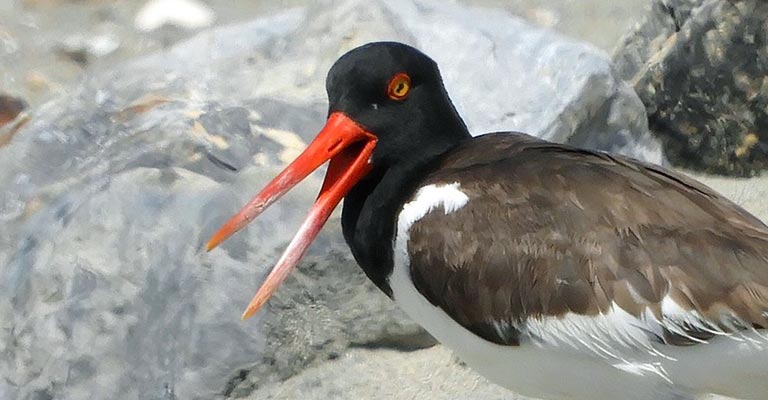
American Oystercatchers are quite vocal birds, emitting loud, distinct calls that are often described as a series of sharp, piping whistles.
These calls are commonly heard during their breeding season and while defending their territory.
Habitat
As their name suggests, American Oystercatchers are commonly found along coastal areas, including sandy beaches, mudflats, salt marshes, and rocky shorelines.
They prefer habitats where they can easily access their favorite prey, oysters, clams, and mussels.
Behavior
One of the key behaviors that help identify American Oystercatchers is their feeding technique.
They use their strong bills to hammer or pry open the shells of mollusks, often seen probing into the sand or mud with their bills to uncover buried prey.
Flight Pattern
While in flight, American Oystercatchers display a distinctive pattern. Their wings are broad and rounded, with white patches visible on the upperparts.
Their flight is usually direct and swift, with rhythmic wingbeats and occasional glides.
Breeding Season Display
During the breeding season, American Oystercatchers engage in elaborate courtship displays.
This may involve aerial displays, where they circle each other while calling loudly, as well as ground displays, where they strut and bow to each other.
Identifying an American Oystercatcher involves paying attention to its distinctive size, shape, coloration, bill shape, habitat preference, vocalizations, feeding behavior, flight pattern, and breeding season displays.
By combining these key characteristics, birdwatchers can confidently recognize and appreciate this iconic shorebird along the coasts of North and South America.
Taxonomy of American Oystercatcher
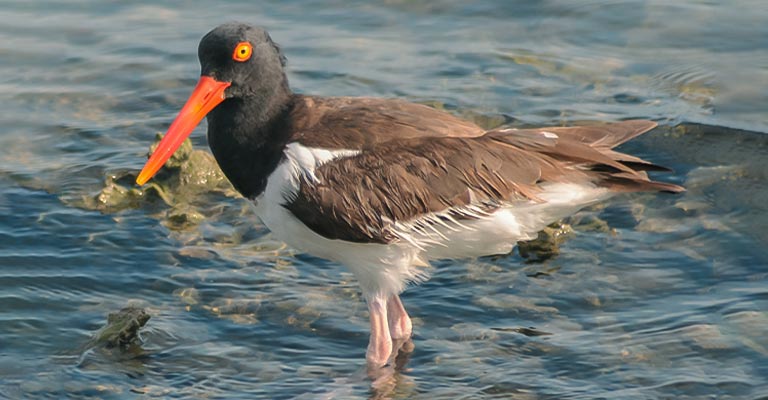
Here’s a table outlining the taxonomy details of the American Oystercatcher:
| Domain | Eukaryota |
| Kingdom | Animalia |
| Phylum | Chordata |
| Class | Aves |
| Order | Charadriiformes |
| Suborder | Charadrii |
| Family | Haematopodidae Bonaparte, 1838 |
| Genus | Haematopus |
| Species | H. palliatus |
The American Oystercatcher (Haematopus palliatus) belongs to the family Haematopodidae within the order Charadriiformes. This order encompasses various shorebirds and gulls.
Within the family Haematopodidae, the American Oystercatcher is closely related to other oystercatcher species, including the Eurasian Oystercatcher and the African Oystercatcher.
The genus Haematopus consists of eleven species distributed worldwide, each adapted to different coastal habitats.
The taxonomy of the American Oystercatcher highlights its evolutionary relationships with other shorebird species and provides insight into its ecological niche within coastal ecosystems.
American Oystercatcher Life History
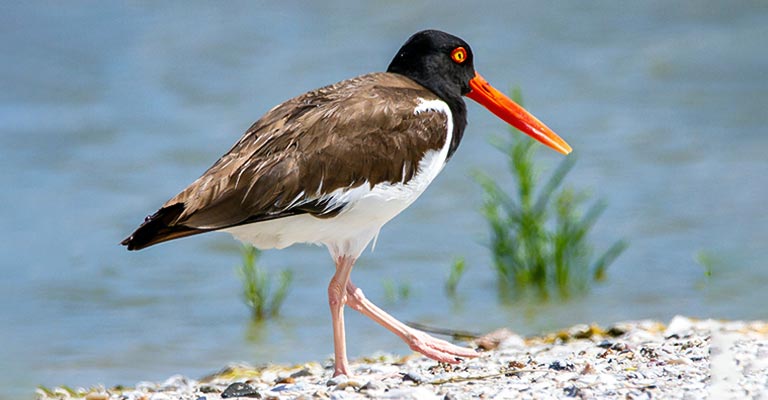
The American Oystercatcher (Haematopus palliatus) is a charismatic shorebird known for its distinctive appearance and behavior.
With its striking black and white plumage, vital orange bill, and loud calls, this species captures the attention of birdwatchers along the coastal regions of North and South America.
Understanding the life history of the American Oystercatcher provides insights into its ecological role, conservation needs, and the challenges it faces in its environment.
Food
American Oystercatchers primarily feed on bivalve mollusks such as oysters, clams, and mussels.
They have specialized bills that are adapted for prying open the shells of these shellfish. Additionally, they may also consume other invertebrates, such as crabs, worms, and small crustaceans.
Their foraging behavior often involves probing into sand or mud to locate buried prey, and they are known to follow the tides to access feeding grounds.
Habitat
These birds are typically found in coastal habitats, including sandy beaches, mudflats, salt marshes, and rocky shorelines. They prefer areas where there is ample availability of their preferred food sources, particularly shellfish beds.
American Oystercatchers are also known to nest on islands or sparsely vegetated coastal areas, providing them with suitable breeding habitat away from potential predators.
Range Map
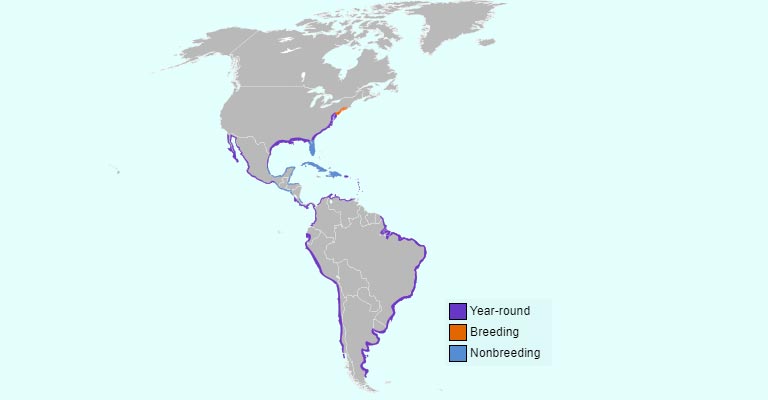
The range of the American Oystercatcher extends along the Atlantic and Gulf coasts of the United States, as well as the coastlines of Mexico, Central America, and northern South America.
They are also found in some parts of the Caribbean. Range maps illustrate their distribution across these coastal regions, highlighting the areas where they are commonly observed and where conservation efforts are particularly important.
Breeding
Breeding season for American Oystercatchers typically occurs from April to August. They form monogamous pairs and often return to the same breeding sites year after year.
Nests are simple scrapes in the sand or gravel lined with shell fragments or other debris. The female usually lays two or three eggs, which both parents take turns incubating for about 25 to 28 days.
After hatching, the chicks are precocial and able to leave the nest within hours to feed with their parents.
Diseases and Treatment
American Oystercatchers may be susceptible to various diseases, including avian botulism, avian influenza, and parasites.
Conservation organizations and wildlife veterinarians monitor populations for signs of disease outbreaks and may provide treatment or preventive measures when necessary.
Research into the health of oystercatcher populations helps to inform conservation strategies aimed at maintaining healthy populations.
Conservation
Conservation efforts for American Oystercatchers focus on protecting their coastal habitats, managing human disturbance, and mitigating threats such as habitat loss, pollution, and climate change.
Conservation organizations work collaboratively with government agencies, researchers, and local communities to implement measures such as habitat restoration and public education campaigns to raise awareness about the importance of conserving these iconic shorebirds.
The life history of the American Oystercatcher is intricately linked to the coastal ecosystems it inhabits.
By understanding its feeding habits, habitat preferences, breeding biology, health concerns, and conservation needs, we can work towards ensuring the long-term survival of this charismatic species along the shores of the Americas.
Nesting Habit of American Oystercatcher
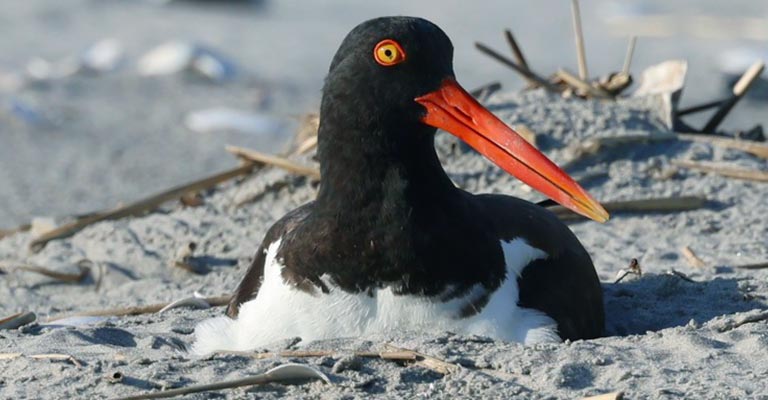
A table outlining the nesting details of the American Oystercatcher is given below:
| Nesting Detail | Description |
| Clutch Size | 2-3 eggs |
| Number of Broods | A simple scrape in the sand or gravel, sometimes lined with shell fragments or other debris. Typically located on sparsely vegetated coastal areas or islands, away from potential predators such as mammals and other birds. It may be located above the high tide line to avoid flooding during high tides. |
| Egg Length | Approximately 2.5 inches (6.4 cm) |
| Egg Width | Approximately 1.8 inches (4.6 cm) |
| Incubation Period | 25-28 days |
| Nestling Period | Approximately 25-35 days until fledging |
| Egg Description | Smooth, glossy, and generally pale olive to buff with dark brown or black spots, providing camouflage against the nest substrate. |
| Nest Description | A simple scrape in the sand or gravel, sometimes lined with shell fragments or other debris. Typically located on sparsely vegetated coastal areas or islands, away from potential predators such as mammals and other birds. May be located above the high tide line to avoid flooding during high tides. |
These nesting details provide insight into the reproductive biology and nesting behavior of the American Oystercatcher, highlighting its adaptations for breeding success in coastal environments.
American Oystercatchers typically lay 2-3 eggs in a shallow scrape on sandy or gravelly beaches, often lined with shell fragments. Nest sites are carefully chosen to avoid potential predators and flooding during high tides.
Both parents share the responsibility of incubating the eggs for about 25-28 days. Once hatched, the chicks are precocial and leave the nest shortly after birth, relying on their parents for warmth and protection.
They fledge within 25-35 days, becoming independent but still receiving parental care and guidance.
This nesting strategy allows American Oystercatchers to successfully raise their young in the dynamic coastal environment.
10 Behavioral Habits of American Oystercatchers
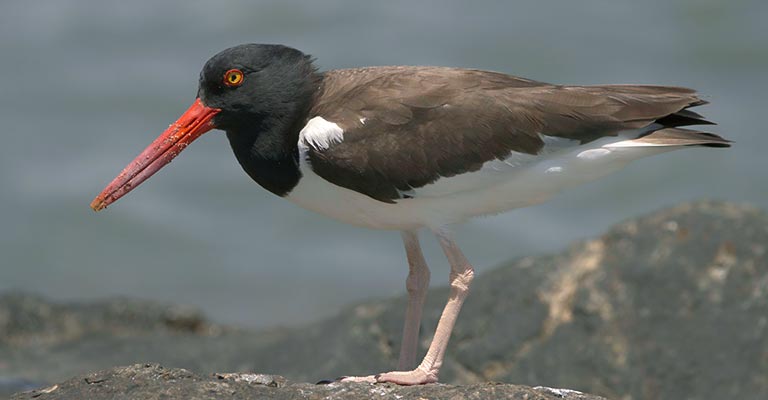
American Oystercatchers exhibit a fascinating array of behavioral habits that are essential for their survival in coastal environments.
From foraging techniques to social interactions, these behaviors provide insights into the ecological niche occupied by these charismatic shorebirds.
- Feeding Behavior: American Oystercatchers are specialized foragers, using their distinctive long, orange bills to pry open the shells of bivalve mollusks such as oysters, clams, and mussels. They also feed on other invertebrates like crabs and worms, probing into sand or mud to locate their prey.
- Territoriality: During the breeding season, American Oystercatchers fiercely defend their nesting territories from intruders. They engage in loud vocalizations and aggressive displays to deter rivals and protect their nesting sites.
- Courtship Displays: Courtship displays are elaborate rituals performed by pairs of American Oystercatchers during the breeding season. These displays involve aerial acrobatics, mutual preening, and vocalizations, strengthening the bond between mates.
- Parental Care: Both parents play active roles in incubating the eggs and caring for the chicks. They take turns keeping the eggs warm and guarding the nest against predators. After hatching, the parents feed and protect the chicks until they are independent.
- Social Behavior: American Oystercatchers are often observed in small groups, especially outside of the breeding season. They may congregate on sandy beaches or mudflats, roosting together and engaging in social interactions such as allopreening.
- Mobility: These birds are highly mobile, moving between different foraging sites in response to changes in tide and prey availability. They may also undertake seasonal migrations, traveling hundreds of miles between breeding and wintering grounds.
- Vocalizations: American Oystercatchers are vocal birds emitting loud, distinctive calls that serve various purposes, including mate attraction, territory defense, and communication within pairs or groups.
- Nest Building: Nest building involves creating a shallow scrape in the sand or gravel, often lined with shell fragments or other debris. The location of the nest is carefully chosen to minimize the risk of predation and flooding.
- Aggression: American Oystercatchers can be aggressive towards perceived threats, including predators, competitors, or human disturbances. They may dive-bomb intruders or engage in territorial disputes with neighboring pairs.
- Adaptability: Despite facing various challenges in their coastal habitats, American Oystercatchers demonstrate remarkable adaptability in their behaviors, allowing them to thrive in dynamic and ever-changing environments.
The behavioral habits of American Oystercatchers reflect their specialized adaptations to coastal life, highlighting their resilience and importance within marine ecosystems.
Wrapping Up
The American Oystercatcher exemplifies the intricate relationship between behavior, ecology, and survival in coastal environments.
From specialized foraging techniques to elaborate courtship displays, these birds exhibit a diverse range of behaviors that contribute to their adaptation and success along the shorelines of North and South America.
Appreciating these behavioral habits not only enriches our knowledge of avian ecology but also underscores the importance of conservation efforts to protect these charismatic shorebirds and their coastal habitats for future generations. Thank you so much.